Fiscal Sustainability Plan
Overview
The City of Sammamish is taking proactive steps to achieve long term fiscal sustainability. The City embarked on a two-phase project beginning in 2022: The initial phase leveraged historical financial data from the prior decade to construct a robust financial forecasting model. In the second phase, the City used this forecast to develop a draft Fiscal Sustainability Plan to provide guidance moving forward.
The City hired consulting firm Baker Tilly and convened a ten-member community taskforce, referred to as the Fiscal Sustainability Task Force, to review the City's finances and propose a plan to address the City's structural budget imbalance. The Taskforce validated that the City had a structural imbalance and presented a recommended approach to Council in 2023. The approach included three phases:
Phase 1 - City Responsibility: The City's responsibility was to reduce the general fund by $1 million over 3-years starting in 2025. This was accomplished and resulted in budgetary reductions of over $8.9 million in the General Fund for the 2025-2026 biennium.
Phase 2 - Council Responsibility: The Council's responsibility was to implement councilmanic taxes in the form of a utility tax starting in 2026. The Taskforce recommended a 6% tax rate on all utilities, with an estimated annual revenue of approximately $11 million. It should be noted that the 6% utility tax will not fully address the structural imbalance long term.
The Utility Tax Ordinance passed by Council in March 2025 implemented a 6% utility tax on natural gas, electricity, telecom, cable, water, sewer, surface water (storm), and solid waste utilities. In addition, the legislation created a low barrier program for residents to access utility tax relief; qualifying households are eligible for $200 per single-family or multi-family household annually.
Phase 3 - Voter Responsibility: The Taskforce stated that the voters' responsibility is to pass a voter-approved measure, with the recommended strategy being a Metropolitan Park District. The voter-approved measure will come before Council at a later date for review and consideration. For more information about these phases, please read the Taskforce's recommendation.
Why is this project needed?
The City needs a balanced budget so it can provide services reliably over time. The City must determine how to best serve the community within its revenue. The cost to provide City services at the same level is rising faster than revenues are increasing, particularly for the City's largest operating expenses - its contracts for police and fire services.
The City maintains a strategic reserve of operating expenses. Having a buffer allows the City to ensure continuity of service and be prepared for emergencies. To balance future budgets, the City may need to reduce its spending, increase its revenue, or a combination. Through this project, the City is proactively addressing the anticipated shortfall. It is fiscally prudent to plan ahead for a future budget gap because solutions will take time to implement.
Fiscal Sustainability Taskforce
Applications for the Fiscal Sustainability Taskforce have closed.
The City Manager created an advisory taskforce for this project that learned about the financial forecast, deliberated budget strategies, and developed a recommended approach.
The taskforce met through the summer of 2023 and presented their recommendations to the City Manager and City Council on September 19, 2023.

Taskforce Meeting Materials
Taskforce Meeting #1 - June 22, 2023:
Taskforce Meeting #2 - July 13, 2023
Taskforce Meeting #3 - July 27, 2023
Taskforce Meeting #4 - August 10, 2023
Taskforce Meeting #5 - Presentation to City Council - September 19, 2023
Meeting #6 - City Council Discussion - November 21, 2023
Post-Taskforce Meeting Materials - Utility Tax
Following completion of the Taskforce's recommendations, the Council discussed the City's financial situation and the need for a utility tax in detail throughout development of the City's 2025-2026 budget. Documents related to the budget meetings can be found here.
After adopting the budget at the end of 2024, the Council discussed next steps for long term fiscal sustainability, leading to the approval of the 6% utility tax in March 2025. Please view the meeting materials below for more information.
City Council Retreat - Discussion on Taskforce Recommendations and Next Steps - February 8, 2025
City Council Meeting - Public Hearing on Utility Tax Ordinance - February 18, 2025
City Council Meeting - Public Hearing on Utility Tax Ordinance - March 4, 2025
City Council Meeting - Public Hearing on Utility Tax Ordinance and Approval - March 18, 2025
Frequently Asked Questions
How far ahead does the City create budgets?
The City operates on a two-year (biennial) budget. The current budget was adopted by City Council in November 2024, setting the City’s 2025-2026 biennial budget.
The City follows the Government Finance Officer Association (GFOA) best practices in budgeting. After adoption of the City's budget, a long-term forecast is developed. This projects future forecasted revenues and expenditures over a six-year planning horizon. The most recent financial forecast is included as part of the 2025-2026 biennial budget document.
What kinds of expenses are included in the City budget?
Both operating and capital expenses are included in the City budget.
Some examples of operating expenses are the costs of staffing, supplies, programs, planning, training and maintenance. Notably, the largest operating expenses for the City of Sammamish are its two public safety contracts with Eastside Fire & Rescue (fire and emergency services) and the King County Sheriff’s Office (police services).
Examples of capital expenses are infrastructure investments in roads, sidewalks, parks and trails, stormwater systems, fire stations, and other public facilities and equipment.
Where does the City currently receive revenue from?
The City receives most of its revenue from the local share of property tax and to a lesser extent sales tax. These two general funding sources can be used for any aspect of City governance.
Some other sources of funding, such as criminal justice sales taxes, permit and service fees and real estate excise taxes, are restricted to be used for certain specific purposes.
Outside grant funding supplements these sources of city revenue. Grant funding allows the City to provide additional services and build projects that might otherwise be unaffordable. The City has received and continues to pursue grant funding from a variety of county, State, and Federal sources.
